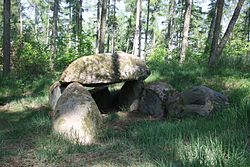Great stone graves at Bollewick
| Great stone graves at Bollewick Large stone grave Fuchstannen (grave 1), sacrificial stone (grave 2) | ||
|---|---|---|
|
The great stone grave Bollewick 1 |
||
|
|
||
| Coordinates | Bollewick 1 , Bollewick 2 | |
| place | Bollewick , Mecklenburg-Western Pomerania , Germany | |
| Emergence | 3500 to 2800 BC Chr. | |
| Sprockhoff no. | 447 | |
The megalithic graves near Bollewick are believed to be two megalithic graves from the Neolithic funnel beaker culture near Bollewick in the Mecklenburg Lake District ( Mecklenburg-Western Pomerania ). Grave 1 is also called the Fuchstannen large stone grave and bears the Sprockhoff number 447. It was archaeologically examined in 1972 under the direction of Adolf Hollnagel . The only remnants of grave 2 is also called the sacrificial stone .
location
Grave 1 is located west of Bollewick in the northwest corner of the small forest "Fuchstannen". Grave 2 is 3.2 km east of this in a field. There are several other large stone graves in the vicinity. 230 m southwest of grave 1 are the large stone graves at Karchow and 740 m southwest of the large stone grave Erlenkamp . 3–4 km to the north and northwest are the megalithic graves near Dambeck . The Spitzkuhn large stone grave is located 2.1 km south-southwest of grave 2 .
description
Grave 1
The complex has a north-west-south-east oriented, 1.7 m long, 1.2 m wide and 1.5 m high burial chamber , which is to be addressed as an extended dolmen . Before the investigation, only two wall stones standing in situ on the north-eastern long side, the north-western end stone also standing in situ and a shifted cap stone were recognizable. The position of some of the stones lying around could not be determined at first; they later turned out to be the remains of a blasted second cap stone. The two wall stones on the southwest side were only discovered during the excavation . They were inclined outwards and completely covered with earth. In 1993 they were erected again and the completely preserved capstone was put back on. The south-eastern narrow side had no wall stone and instead was originally built with granite slabs and rolling stones. On the northeast side, a pebble packing could also be detected, which probably belonged to the original round mound, but which had been completely removed on the other sides. The interior of the chamber also turned out to be severely disturbed. The pavement made of granite pieces could still be found, but the dry stone masonry between the wall stones, also made of granite, was only preserved in the lowest layer. Modern glass fragments were found in the humus soil with which the chamber was filled. Of the original burials, only the distal end of a human tibia was discovered. Only two undecorated ceramic shards remained from the grave goods.
Grave 2
Of grave 2, only a single, with is bowl -provided Findling received. Ewald Schuldt interpreted it as the last remnant of a large stone grave.
literature
- Hans-Jürgen Beier : The megalithic, submegalithic and pseudomegalithic buildings as well as the menhirs between the Baltic Sea and the Thuringian Forest. Contributions to the prehistory and early history of Central Europe 1. Wilkau-Haßlau 1991, p. 34.
- Adolf Hollnagel : The extended dolmens of Bollewick, Karchow and Erlenkamp, Röbel district. In: Ground monument maintenance in Mecklenburg. Yearbook 1974. 1975, pp. 55-67.
- Ewald Schuldt : The Mecklenburg megalithic graves. Research on their architecture and function. VEB Deutscher Verlag der Wissenschaften, Berlin 1972, p. 137.
- Ernst Sprockhoff : Atlas of the megalithic tombs of Germany. Part 2: Mecklenburg - Brandenburg - Pomerania. Rudolf-Habelt Verlag, Bonn 1967, p. 49.
Web links
- megalithic.co.uk: Bollewick Stone Grave , Bollewick Sacrificial Stone
- kleks-online.de: Extended Dolmen Bollewick , Sacrificial Stone Bollewick
- grosssteingraeber.de: The large stone grave "Fuchstannen" (Bollewick) near Röbel
- strahlen.org: Large stone grave near Bollewick, southwest of Röbel
- Megalithic grave "Fuchstannen" near Bollewick

